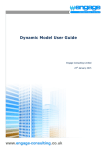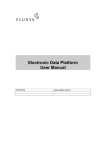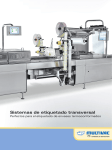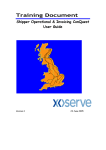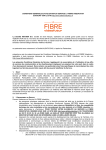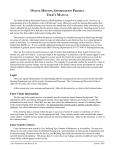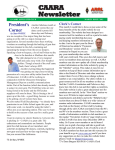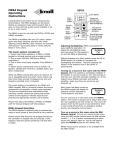Download D\namic Model User Guide 9ersion 3.0
Transcript
Engage Contact Details: +44 7827973224 [email protected] Dynamic Model User Guide Version 3.0 Engage Consulting Limited 29th January 2015 Engage Consulting Limited www.engage-consulting.co.uk Registered in England, number: 3923081 Registered Office: 1st Floor Rear, 85 Hatton Garden, London EC1N 8JR VAT Registration: 754 7463 04 Page 1 of 24 Engage Contact Details: +44 7827973224 [email protected] Document Control Authorities Version Issue Date Author Comments 0.1 19th December 2014 Naomi Anderson First draft for review by the PAW and Ofgem 2.0 23rd January 2015 Naomi Anderson Includes changes to the model and comments from PAW members 3.0 29th January 2015 Naomi Anderson To reflect changes to the model following comments on the final report. Table of Contents Document Control ........................................................................................................................................... 2 Authorities ....................................................................................................................................................... 2 Table of Contents ............................................................................................................................................ 2 1 Introduction .......................................................................................................................................... 4 1.1 2 Description of the Model ...................................................................................................................... 5 2.1 2.2 2.3 2.4 3 Model Construction ...................................................................................................................................... 5 Value at Risk Report ..................................................................................................................................... 5 Net Effect of Settlement Risks ...................................................................................................................... 6 Compatibility ................................................................................................................................................ 6 How to Navigate Through the Model ................................................................................................... 7 3.1 3.2 4 Background ................................................................................................................................................. 4 Menu ........................................................................................................................................................... 7 Using the model ........................................................................................................................................... 7 Using the Model to Assess Performance Risks .................................................................................... 8 4.1 4.2 4.3 4.4 4.5 4.6 4.7 4.8 4.9 4.10 4.11 4.12 4.13 4.14 4.15 R1. Identified LDZ Offtake Measurement Errors ............................................................................................. 8 R2. LDZ Offtake Measurement Errors that remain undetected ........................................................................ 9 R3. Meter Reading Validation Failure ........................................................................................................... 10 R4. Failure to Obtain a Meter Reading......................................................................................................... 11 R5. Estimated Reads used for daily read sites .............................................................................................. 11 R6. Meter Read Submission Frequency for Product 4 ................................................................................... 12 R7. Insufficient Maintenance of the Supply Point Register ............................................................................ 13 R8. Change of Shipper ............................................................................................................................... 15 R9. Late or Incomplete Check Reads ........................................................................................................... 16 R10. Shipperless Sites ................................................................................................................................ 17 R11. Theft of Gas ....................................................................................................................................... 18 R12. Fair Use of the AQ Correction Process ................................................................................................. 18 R13. Lack of Winter Annual Ratio Band calculation for Sites in Product 4 ...................................................... 19 R14. Bias approach to retrospective updates ............................................................................................... 20 R15. Unregistered Sites .............................................................................................................................. 21 Engage Consulting Limited www.engage-consulting.co.uk Registered in England, number: 3923081 Registered Office: 1st Floor Rear, 85 Hatton Garden, London EC1N 8JR VAT Registration: 754 7463 04 Page 2 of 24 Engage Contact Details: +44 7827973224 5 [email protected] Updating Reference Data and Running Scenarios ............................................................................. 22 5.1 5.2 5.3 Shipper Matrix ........................................................................................................................................... 22 Common Data............................................................................................................................................ 22 Updating Risk Parameters........................................................................................................................... 23 Engage Consulting Limited www.engage-consulting.co.uk Registered in England, number: 3923081 Registered Office: 1st Floor Rear, 85 Hatton Garden, London EC1N 8JR VAT Registration: 754 7463 04 Page 3 of 24 Engage Contact Details: +44 7827973224 1 1.1 [email protected] Introduction Background This user guide describes how to use the dynamic model, built in Excel, which simulates the Project Nexus settlements processes. The model will be used by the PAW to assess each performance risk identified within the Gas Market Settlement Risk Assessment report. The model simulates the post Nexus settlement arrangements for an averaged sized LDZ with seven shippers operating in a competitive market. The core model is set up to replicate gas settlements without any risk to allocation or reconciliation volume for one day. To assess each risk the model uses an error distribution to identify the 1 in 20 worst-case event and quantify the inaccuracy that it would create if it materialised. Each risk can affect products 1-4 differently. The risk in kWh per day is run through the model to determine the value at risk and how it is distributed among shippers in the LDZ. The PAW will be able to update key reference data and run different scenarios to find the most appropriate value at risk. The model assesses the following risks: 1. Identified LDZ offtake measurement errors; 2. Undetected LDZ measurement errors; 3. Meter read validation failure; 4. Failure to obtain meter readings; 5. Estimated reads used on daily read sites; 6. Meter read submission frequency for product 4; 7. Insufficient maintenance of the supply point register; 8. Estimates used at change of shipper; 9. Late or incomplete check reads; 10. Shipperless sites; 11. Theft of Gas; 12. Fair Use of the AQ correction process; 13. Lack of WAR Band calculation for qualifying sites in product 4; 14. Fair use of retrospective updates; and 15. Unregistered sites This document and the dynamic model assumes the reader has an understanding of the current and future settlement arrangements. Engage Consulting Limited www.engage-consulting.co.uk Registered in England, number: 3923081 Registered Office: 1st Floor Rear, 85 Hatton Garden, London EC1N 8JR VAT Registration: 754 7463 04 Page 4 of 24 Engage Contact Details: +44 7827973224 2 2.1 [email protected] Description of the Model Model Construction The model uses common data to convert the gas volume entering into an LDZ into identified and unidentified gas. These two categories are then split by product category to derive the initial allocation and reconciliation volume. The market shares are used to divide the energy allocation between the 7 shippers in the market. The reconciliation process simulates individual meter point reconciliation and the redistribution of energy through unidentified gas. The energy will be redistributed to Shippers’ based on an approximation of consumption over the last 12 months. Market share data is used as an approximate value. The model has market share data at the start and end of a model year and uses the average of the two values; this assumes a linear change from start to end. The basic model structure is shown below. Each of the risks vary the initial allocation or final reconciliation or both as they are fed through the model. The parameter control element of each risk determines which product category the risk impacts. 2.2 Value at Risk Report The Value at Risk (VAR) is determined as the difference between the cost incurred between the reference scenario (where there are no risks) and the scenario where the cumulative probability is 95%. The 95% worst-case scenario uses normal or binomial distributions shown in appendix A. The relevant distribution is determined dependant on whether the data is discrete or continuous. The graph below shows the probability distribution of a normal and binomial function. Likelihood Most likely scenario Low Black Scenario Pink Scenario Orange Scenario Value at Risk Average metric for each risk 1 in 20 event 95th percentile scenario Engage Consulting Limited www.engage-consulting.co.uk Registered in England, number: 3923081 Registered Office: 1st Floor Rear, 85 Hatton Garden, London EC1N 8JR VAT Registration: 754 7463 04 High Page 5 of 24 Engage Contact Details: +44 7827973224 2.3 [email protected] Net Effect of Settlement Risks Where a risk has equal and opposite effects, only half of the risk is assessed. LDZ meter errors initially effect NTS shrinkage and this cost is then moved to energy allocation. The model does not assess the impact on NTS shrinkage. Similarly, where an estimated transfer read is used the impact to one shipper is evaluated. 2.4 Compatibility We have built the model in Microsoft Excel 2013. It does not contain SQL or macros. This model requires a minimum of Excel 2007 and earlier versions of MS Excel will not display the model correctly. Engage Consulting Limited www.engage-consulting.co.uk Registered in England, number: 3923081 Registered Office: 1st Floor Rear, 85 Hatton Garden, London EC1N 8JR VAT Registration: 754 7463 04 Page 6 of 24 Engage Contact Details: +44 7827973224 3 3.1 [email protected] How to Navigate Through the Model Menu The menu tab is to navigate around the model. The model only assesses one risk at a time. The user should select the risk to assess using the drop down on the menu tab. The selected risk will then be highlighted green. 3.2 Using the model The model simulates an average LDZ for an average settlement day. The model is currently configured to default specifications determined by Engage Consulting and can be run without any configuration by the PAW if desired. The default values are shown in Section 5. The model characteristics are sensitive to the size of shippers within the simulated LDZ and their product uptake. The common data also determines the volume of gas and number of customers. The current breakdown of the market has been determined to reflect reality with shippers having a mixed portfolio of customers. The common data has been determined to be an average LDZ using average data as published on the National Grid website. Some parameters used for probability distributions should be updated with newer information when available; however, in cases where data from the Mod 81 and AUGE reports have been used, model users will need to find alternative data as these reports will not be published in their current format from 2016 onwards. Section 4 describes how to update each risk. Throughout the model, input cells are formatted consistently in in light brown to indicate where the model user can make updates. Engage Consulting Limited www.engage-consulting.co.uk Registered in England, number: 3923081 Registered Office: 1st Floor Rear, 85 Hatton Garden, London EC1N 8JR VAT Registration: 754 7463 04 Page 7 of 24 Engage Contact Details: +44 7827973224 4 [email protected] Using the Model to Assess Performance Risks The model documents which data it has used to determine the 95% worst-case scenario for a risk and where the user can get current data for the model. In some instances, where no data is available, Engage has estimated the impact and probability. When using the model to assess each risk use the menu tab to move between risks. The table embedded within each risk shows the value at risk to shippers 1-7. This VAR is driven by product uptake and shipper market share. If this table is red, then risk is not the currently selected risk – see the menu tab for how to select a risk. 4.1 R1. Identified LDZ Offtake Measurement Errors The model assesses the risk offtake measurement errors create to accurate allocation. The settlement process initially allocates the error to NTS shrinkage. With the correct LDZ throughput, volume adjustments will fall into unidentified gas reconciliation and it will allocate energy to shippers according to their consumption share over the previous 12 months. This error affects all products 1-4 according to their consumption. 4.1.1 Data Used Data from the Measurements Errors Registered, which is kept on the Joint Office website is used to evaluate the probability and impact of an offtake error occurring on an LDZ. The register can be found here: http://www.gasgovernance.co.uk/MER. It is updated periodically when measurement errors are identified. We have used the following data: 4.1.2 • Number of meter errors: 127 errors; • Total number of offtake meters: 187 offtake meters; • Period: 8 years; • Average error which has been reported: 96,781 kWh per day; • Average length per error: 297 days; and • Total length period: 3650 days. Determining the 95% Worst-case Scenario In each case we are assessing the probability of the number of offtake meter errors occurring in our average LDZ on any given day. This can be approximated by a binomial probability distribution. The parameters are as follows; • n is the average number of offtake meters in an LDZ. This has been determined to be number of meters/number of LDZs; and Engage Consulting Limited www.engage-consulting.co.uk Registered in England, number: 3923081 Registered Office: 1st Floor Rear, 85 Hatton Garden, London EC1N 8JR VAT Registration: 754 7463 04 Page 8 of 24 Engage Contact Details: +44 7827973224 • [email protected] p is the probability of 1 meter having an error on any given day. This is determined as number of meter errors/ number of meters X average length per error/ total period measured. Using this distribution X-Binomial (14.38, 0.0641), where the number of meters is 14.38 and the probability of each one having an error is 6.41%. The 95% worst-case scenario has been determined as 3 errors within the same LDZ on the same day. 4.1.3 Updating the Data When the Measurement Error Register has new data, the model’s user can use this to determine new inputs for this risk. The inputs derived from the Measurement Error Register are; the probability of an LDZ measurement error occurring on a given day, the average length of an LDZ meter error, the overall time that the sample covers and the total number of errors over the sample period. Number of LDZ Off take Errors 127 Measurement Error reports total Total Number Offtake Meters 187 All the offtake meters on the system Average Days per Error 297 Total Metering errors Average Error per fault day Latest end date- earliest start date Probability of an error occuring per day Number of offtake meters per LDZ 1 in 20 worst case no of faults Energy error for VAR 3650 Information comes from measurement error register to be over written by the PAW (GWh) Information comes from measurement error register to be over written by the PAW 96,781 kWh Information comes from measurement error register to be over 3260 written by the PAW 0.0619 Probability of a meter having a fault on any day 14.38 Average LDZ meters Using a binomial distribution with n = no of Offtake meters 3.00 and p=probability of an error occuring per day 290,342 Daily kWh error The model’s user should update Risk 01 data with a refreshed version of the Measurement Errors Register following the identification and evaluation of an offtake meter error. Records with errors that do not have a start and end date must be removed. 4.2 R2. LDZ Offtake Measurement Errors that remain undetected Where an offtake measurement error is not detected then the error will never be corrected. Where an error occurs and remains undetected, the proportion of NTS Shrinkage will remain inaccurate. The model assess the risk to initial allocation and final reconciliation following the end of the settlement window. This risk affects all products 1-4. 4.2.1 Data Used Risk 2 should also be updated with information from the Measurement Errors Register. We have used the same data as risk 1 and added the probability of an error remaining undetected. 4.2.2 Determining the 95% Worst-case Scenario In each case, we are assessing the probability of the number of offtake meter errors occurring on our average LDZ on any given day and not being detected. This can be approximated by a Binomial probability distribution X – Binomial (n, p). Where n = 14.38 (number of meters on an average LDZ) and p = (number of meter errors/ number of meters) X (average length per error/ total period measured) X probability of remaining undetected. We have determined the detection probability as 10%. If the probability of detection falls below 5% this risk diminishes. Engage Consulting Limited www.engage-consulting.co.uk Registered in England, number: 3923081 Registered Office: 1st Floor Rear, 85 Hatton Garden, London EC1N 8JR VAT Registration: 754 7463 04 Page 9 of 24 Engage Contact Details: +44 7827973224 4.2.3 [email protected] Updating the Data The PAW should update the probability of a meter error occurring and the probability of it remaining undetected. 4.3 R3. Meter Reading Validation Failure The model assesses the risk caused by meter read validation failure. Validation failure will occur when a comparison of the reading (and advance) against an expected value falls outside either of the two tolerance levels derived from the current AQ and/or SOQ. When meter read validation failure occurs individual meter point reconciliation is suppressed, and the historical AQ remains live. It is likely that as consumption trends are falling this AQ will be on average, higher than actual consumption. The responsible shipper will pay for more gas than the supply point consumes and this will adjust unidentified gas accordingly. A risk to other shippers is created when the shipper pays for less gas than their customers consume. The principle risk because of meter read failure are inaccurate AQs and delayed reconciliations. There is a corresponding impact of late reconciliation on the unidentified gas reconciliation energy. This risk affects product 4 only. 4.3.1 Data Used The Mod 81 report 10 provides the following data; • Average AQ; • Percentage change in AQ between 2013 and 2014;and • Standard deviation of the percentage change. Xoserve’s data of latest meter reading date, for all MPRNs in the East Midlands has been used to the number of MPRNs within the model that have not had a meter read accepted by Xoserve within the last 12 months. 18,698.2 From Common Data Average AQ -2.16% Mod 81 Report- EUC 01-08 Average AQ change between 13-14 Standard Deviation Average Decrease in AQ Standard Deviation 1 in 20 Scenario - Change in consumption Percentage of MPRN not read in a year Energy error for VAR 4.3.2 - 2.97% 538 556 377 5.53% 125,476 Spread of Change in AQ values between Shippers Derived using a normal distribution Data provided using Xoserve's sample data Daily kWh error Determining the 95% Worst-case Scenario The model uses a normal distribution and average AQ change to determine the 95th percentile scenario. We have derived the average AQ change using the Mod 81 report. 4.3.3 Updating the Data Users of the model will need to find an alternative source for the average AQ and the rate of AQ change following Nexus go-live when the currents reports are no longer available. Engage Consulting Limited Page 10 of 24 www.engage-consulting.co.uk Registered in England, number: 3923081 Registered Office: 1st Floor Rear, 85 Hatton Garden, London EC1N 8JR VAT Registration: 754 7463 04 Engage Contact Details: +44 7827973224 4.4 [email protected] R4. Failure to Obtain a Meter Reading The model assesses the risk of shippers failing to obtain meter reads within the settlement window of 36-48 months. For ease of assessment, we have determined the settlement window to be 42 months (the average of 36 and 48). Where reads are not obtained, the current AQ will be out of date and the MPRN will have incomplete reconciliation. This risk affects product 4 only. 4.4.1 Data Used Where the current AQ is historical, the true consumption is more likely to differ from the AQ. To assess the risk we have used data from Xoserve to determine the percentage of sites that do not have a read accepted on the UK Link system within the last 42 months. We have used the last 4 years’ Mod 81 reports to determine average yearly reduction in AQ. Sample of latest meter read > 42 months Total Percentage of MPRNs with latest read outside the settlement window Average AQ 2011 1 in 20 consumption change in 2011 Average AQ 2012 1 in 20 consumption change in 2012 Average AQ 2013 1 in 20 consumption change in 2013 Average AQ 2014 1 in 20 consumption change in 2014 Total change over 42 months 4.4.2 4,811 Sample provided by Xoserve of East Midlands 2,191,244 Samples provided by Xoserve of East Midlands 0.22% 20,451 678 19,458 143.65 19,469 824.05 18,698 510.58 1,817.43 Samples provided by Xoserve of East Midlands Mod 81 Report 10 Normal Distribution Mod 81 Report 10 Normal Distribution Mod 81 Report 10 Normal Distribution Common Data Normal Distribution kWh error per MPRN Determining the 95% Worst-case Scenario We have applied a normal distribution to the last 4 years Mod 81 data to determine the compound 95% worst-case difference between the AQ and the true consumption of the MPRNs that have not had a meter reads accepted by Xoserve. In each case, the worst case is determined to be where the AQ is understated. 4.4.3 Updating the Data The model’s user will need to find a new source of average AQ and the rate of AQ change following Nexus go-live. It may be possible to request from Xoserve an ad-hoc report showing the latest meter read acceptance date. 4.5 R5. Estimated Reads used for daily read sites The model assesses the risk of estimated reads being used to settle daily read sites. Daily read estimates for product 1 and 2 are generated to repeat the consumption from a week ago (7 days previously) and where there is no consumption history an estimate of AQ/365 will be used. The use of estimated reads will only materially affect settlement if there is no replacement read within gas flow day+5. MPRNs with significant usage can have volatile consumption. Only when an actual read is submitted or when a check read is completed will the correct consumption for a site be determined. The model assesses the impact of estimated reads being used for dailymetered sites at initial allocation and evaluates where check reads are not completed. 4.5.1 Data Used The number of daily read estimates is derived using the total number of daily read sites and applying the percentage read failure falling outside both tolerance levels. Xoserve published this for the Project Nexus meeting on 24th November 2014. The risks is split into product 1 and product 2, which can be updated separately as transporters are responsible for check reads on sites in product 1 and shippers are responsible for updating sites in product 2. Engage Consulting Limited Page 11 of 24 www.engage-consulting.co.uk Registered in England, number: 3923081 Registered Office: 1st Floor Rear, 85 Hatton Garden, London EC1N 8JR VAT Registration: 754 7463 04 Engage Contact Details: +44 7827973224 [email protected] Data from the Mod 81 report has been used to determine the average AQ for EUC 07-09. Total number of reads for product 1 1,100 Total number of reads for product 2 From shipper matrix tab From shipper matrix tab 2,200 Percentage read failure for product 1 1.6% Percentage that fail outer tolerance from Xoserve's data provided to the Nexus Workgroup on 24th November 2014- To be updated by the PAW with more accurate information. Percentage read failure for product 2 1.6% Percentage that fail outer tolerance from Xoserve's data provided to the Nexus Workgroup on 24th November 2014- To be updated by the PAW with more accurate information. Number of estimated reads for product 1 Number of estimated reads for product 2 Average yearly AQ change by MPRN for Product 1 Standard Deviation Average yearly AQ change by MPRN for Product 2 Standard Deviation in AQ change for Product 2 Average energy between estimate and actual product 1 1 in 20 Scenario annual estimated difference for product 1 Average energy between estimate and actual Product 2 1 in 20 Scenario annual estimated difference Product 2 Percentage of check reads completed by transporters Percentage of check reads completed by shippers Initial Energy error for P1 Initial Energy error for P2 18 35 840,154 8,227,834 840,154 8,227,834 2,302 39,380 2,302 39,380 99.8% 99.8% Estimates per day (Reads by failure rate) Estimates per day 2014 Mod 81 Report 10 - EUC 07, 08 and 09, from Risk 05 data sheet 2014 Mod 81 Report 10 - EUC 07, 08 and 09, from Risk 05 data sheet 2014 Mod 81 Report 10 - EUC 07, 08 and 09, from Risk 05 data sheet 2014 Mod 81 Report 10 - EUC 07, 08 and 09, from Risk 05 data sheet kWh per day Daily difference in kWh using a normal distribution kWh per day Daily difference in kWh using a normal distribution Product 1 only Product 2 only 693,089.77 Daily kWh error 1,386,180 Daily kWh error Final Energy error for P1 Final Energy error for P2 1,386.18 Daily kWh error 2,772 Daily kWh error Over time, the average AQ may reduce as smaller MPRNs are elected into product 2. 4.5.2 Determining the 95% Worst-case Scenario A normal distribution has been used to determine the 95% worst-case scenario with μ=840,154 kWh the average AQ change for EUC 07-09 and standard deviation of 8,227,834 kWh. The 95% worst-case scenario has been determined as a daily difference between estimate and actual as 39,452kWh per day. The final settlement error has been determined as 0.2% of reads not being updated within the settlement window. This matches the total average from data in the East Midlands, provided by Xoserve. 4.5.3 Updating the Data The risk needs to be updated with the mean yearly AQ change of products 1 and 2, percentage read failure by product 1 and 2 as well as the percentage check read not completed by product 1 and 2. 4.6 R6. Meter Read Submission Frequency for Product 4 This assesses the risk created by infrequent meter read submissions for sites in product 4. Where read frequency is lower there is a higher chance that the AQ will not reflect true consumption. The risk has been set up to consider all MPRNs in product 4. 4.6.1 Data Used This risk uses similar data to risk three as shown on page 13; Engage Consulting Limited Page 12 of 24 www.engage-consulting.co.uk Registered in England, number: 3923081 Registered Office: 1st Floor Rear, 85 Hatton Garden, London EC1N 8JR VAT Registration: 754 7463 04 Engage Contact Details: +44 7827973224 [email protected] Average AQ 18,698 Common Data Average AQ change between 13-14 -2.16% Mod 81 Report- EUC 01-08 Standard Deviation Average Decrease in AQ Standard Deviation 1 in 20 Scenario - Change in consumption Average number of days between meter reads Energy error for VAR 4.6.2 - 2.97% 538 556 377 136 117,695 Spread of Change in AQ values between Shippers Derived using a normal distribution Data provided using Xoserve's sample data Daily kWh error Determining the 95% Worst-case Scenario The 95% worst-case scenario is determined using a normal distribution that assesses the kWh difference between actual consumption and AQ for all MPRNs from in product 4. 4.6.3 Updating the Data This risk should be updated periodically with the average days between meter readings and average AQ. 4.7 R7. Insufficient Maintenance of the Supply Point Register The model assesses the risk created due to the inaccurate data in the supply point register. Some errors will cause settlement to process a significant consumption error that validation will not ordinarily block. We have used three scenarios to quantify that risk. Where the correction factor is not be correct, where the read factor is not correct and where no assets are attached to confirmed sites. This risk affects products 1-4. 4.7.1 Data Used We have used the data provided by Xoserve to track their data cleanse work in December 2014. Engage Consulting Limited Page 13 of 24 www.engage-consulting.co.uk Registered in England, number: 3923081 Registered Office: 1st Floor Rear, 85 Hatton Garden, London EC1N 8JR VAT Registration: 754 7463 04 Engage Contact Details: +44 7827973224 Potentially incorrect correction factors Percentage of MPRNs potentially with an incorrect correction factor Source: Xoserve's data cleanse reporting December 2014 0.0843% From Xoserve data 1 in 20 worst case - Energy factor is out by a factor of 10 Total energy error for VAR Error split by product meter count P1 P2 P3 P4 Incorrect read factors 10.0 Factor Energy is incorrect by 854,791 Daily kWh error 427 855 153,862 699,646 Daily kWh error Daily kWh error Daily kWh error Daily kWh error Source: Xoserve's data cleanse reporting December 2014 Percentage of MPRNs potentially with an incorrect read factor 0.0076% From Xoserve data 1 in 20 worst case - Energy factor is out by a factor of 10 Total energy error for VAR Error split by product meter count P1 P2 P3 P4 No Assets attached to confirmed sites Percentage of MPRNs potentially with an incorrect read factor 35.3 Factor Energy is incorrect by 293,439 Daily kWh error 147 293 52,819 240,180 Total energy error for VAR Error split by product meter count P1 P2 P3 P4 Daily kWh error Daily kWh error Daily kWh error Daily kWh error Source: Xoserve's data cleanse reporting December 2014 0.1383% From Xoserve data 1 in 20 worst case - AQ accuracy 4.7.2 [email protected] 80% Estimated correctness of the AQ (20% error) 31,180 Daily kWh error 16 31 5,612 25,521 Daily kWh error Daily kWh error Daily kWh error Daily kWh error Determining the 95% Worst-case Scenario To demonstrate the 95% worst-case scenario we have used the following scenarios; 4.7.3 • Correction factors being incorrect by a factor of 10 • Read factors being incorrect by a factor of 35.3 • The AQ of sites with unconfirmed assets being 20% incorrect. Updating the Data On request, Xoserve may be able to provide information around the percentage of MPRNs which have potentially incorrect correction factors, incorrect read factors and unconfirmed assets. Engage Consulting Limited Page 14 of 24 www.engage-consulting.co.uk Registered in England, number: 3923081 Registered Office: 1st Floor Rear, 85 Hatton Garden, London EC1N 8JR VAT Registration: 754 7463 04 Engage Contact Details: +44 7827973224 [email protected] Xoserve currently complete reporting to maintain data quality we anticipate that this will continue; however, there is nothing in UNC code to mandate shippers to maintain problem sites as they are identified. 4.8 R8. Change of Shipper The model assesses the risk created by estimated reads at change of supply on product 4 only. Where the shipper fails to provide any reading during a change of shipper, the transporter will provide an estimate 16 days following the transfer date. Change of shipper reads can be replaced with a shipper agreed within 12 months of the change of supply date. Where a change of shipper is completed using an estimate transfer read, and not replaced with an actual read, the closed reconciliation period of the previous shipper will end on an estimate and the new reconciliation period will begin on the same estimate. An estimated meter reading is used when: • No actual reading was obtained; • No actual is available because the actual transfer read was rejected due to data discrepancies; and • Because a reading failed validation tolerances, due to an incorrect AQ. We have assessed the risk of estimated transfer reads on accurate reconciliation. This risk affects product 4 sites as the length of time between reads provides a higher probability that the estimate will be inaccurate. Where the transfer read does not reflect reality the final allocation of energy to each shipper may be incorrect. Any misallocation in energy affects the two shippers who have been responsible for the meter point. 4.8.1 Data Used Xoserve has provided data for the number of supply point confirmations by month and the percentage of estimated transfer reads used. The percentage of MPRNs that change shipper is deduced using the data provided by Xoserve and the total number of MPRNs on the Mod 81. Xoserve can provide an updated ad hoc report detailing the change of supply percentage, percentage of estimated reads used and the total number of supply points. To determine the average difference in AQ we have used the average reduction from the latest Mod 81 report 10. The average number of days between meter reads for product 4 have been taken from an extract of showing all of the meter readings in the East Midlands. MPRN Sample Size Number of supply point confirmations per year Approximate CoS per day within the LDZ modelled Probability of Estimated Reading Used and not replaced 1 in 20 number of estimated CoS reads per day Average AQ Average AQ change between 13-14 Average Difference in AQ compared to consumption Average time between meter reads in product 4 4.8.2 21,714,664 Mod 81 Report- Total MPRNs 2,782,040 Report from Xoserve 3rd December 2014 CoS activity gas yr 13/14 632 Using the model LDZ size Report from Xoserve December 2014 showing, 0.343 supply point confirmations, estimated reads and SARs. 236 18,698 Common Data -2.16% Mod 81 Report- EUC 01-09 404 136 Report from Xoserve 3rd December 2014 Determining the 95% Worst-case Scenario A binomial distribution has been used with parameters n = number of change of shipper events and p = probability the transfer read remains as an estimate. Engage Consulting Limited Page 15 of 24 www.engage-consulting.co.uk Registered in England, number: 3923081 Registered Office: 1st Floor Rear, 85 Hatton Garden, London EC1N 8JR VAT Registration: 754 7463 04 Engage Contact Details: +44 7827973224 4.8.3 [email protected] Updating the Data Xoserve can provide ad hoc reports on the following; 4.9 • Number of supply point confirmations per month; • Percentage of estimated transfer reads; • Number of SARs that have been accepted; • Latest meter read date which can be used to determine meter read frequency; and • Yearly AQ change. R9. Late or Incomplete Check Reads Nexus rules transfer the check read obligation from transporters to shippers where equipment is in place that derives meter readings. If shippers do not fulfil their obligation there is a risk that metering drift will not be correctly assigned to the right shippers. It may be that all AMR devices derive reads, which has been used as the base case for assessing this risk. Shippers are required to complete check reads for all metering equipment that derives a read within the 12 months for MPRNs in products 1-3 and monthly read sites in product 4 and every 24 months for annually read sites within product 4. This affects product 1-4 which could be all AMR devices. The risk of not completing these check reads is that drift is not identified. 4.9.1 Data Used We have used data from Mod 81 report 10 to determine the average AQ for EUC 03-09; however, we have reduced the estimate to 250,000 to account for I&C sites that are in EUC 01 and 02. The PAW should update this data if a better estimate becomes available. The percentage of sites requiring a check read is determined as the total percentage of I&C MPRNs within the market. We have estimated the number of sites requiring a check reads and the impact of not completing these check reads. We have also estimated the energy consumed by meters in each products. Engage Consulting Limited Page 16 of 24 www.engage-consulting.co.uk Registered in England, number: 3923081 Registered Office: 1st Floor Rear, 85 Hatton Garden, London EC1N 8JR VAT Registration: 754 7463 04 Engage Contact Details: +44 7827973224 Percentage of sites requiring a check read [email protected] 3% Estimate based on the total number of AMRs Average AQ for I&C sites Average difference between check read and actual 1 in 20 event - percentage of late check reads 1 in 20 event - percentage of uncompleted check reads within the settlement window 250,000 2% 15% 0.02% Energy error for initial allocation Energy error for final allocation 135,317 Daily kWh error 180 Daily kWh error Percentage of Product 3 which is I&C energy volume Percentage of Product 4 which is I&C energy volume I&C Energy by Product P1 P2 P3 P4 Total I&C Energy Split P1 P2 P3 P4 Total 75% Engage Estimate - To be Updated by the PAW 5% Engage Estimate - To be Updated by the PAW Proportion of all energy that is I&C in product 1.00% 5.00% 11.25% 3.95% 21% Split of I&C between products 5% 24% 53% 19% 100% Initial Energy error for VAR P1 Initial Energy error for VAR P2 Initial Energy error for VAR P3 Initial Energy error for VAR P4 Final Energy error for VAR P1 Final Energy error for VAR P2 Final Energy error for VAR P3 Final Energy error for VAR P4 4.9.2 Engage estimate (Mod 81 Report 10 EUC 03-09 AQ-906,249) Engage Estimate Engage Estimate Engage Estimate 6,383 31,914 71,807 25,212 Daily kWh error Daily kWh error Daily kWh error Daily kWh error 9 43 96 34 Daily kWh error Daily kWh error Daily kWh error Daily kWh error Determining the 95% Worst-case Scenario The 95% worst case has been estimated as 5% of qualifying sites have not had a check read. Currently there is no data available to enable this estimate to be updated. 4.9.3 Updating the Data The average AQ of I&C sites and the percentage of check reads completed would need to be updated. A report from Xoserve could be used to determine a more accurate AQ for meters that derive reads. 4.10 R10. Shipperless Sites The model evaluates the performance risk created because of shippers erroneously withdrawing from sites that continue to consume gas. All energy consumed by shipperless sites is allocated to unidentified energy. This risk affects product 1-4. 4.10.1 Data Used Xoserve has provided a report on the number of isolations per year. The probability of a site which has been withdrawn from still consuming gas has been determined as 0.05 (5%). The average AQ has been determined using the Mod 81 report. Engage has determined the detection rate 1 year per site. Engage Consulting Limited Page 17 of 24 www.engage-consulting.co.uk Registered in England, number: 3923081 Registered Office: 1st Floor Rear, 85 Hatton Garden, London EC1N 8JR VAT Registration: 754 7463 04 Engage Contact Details: +44 7827973224 Number of Isolations per year 73,473 Xosere Report November 2014 Probability still consuming gas 0.05 Engage Estimate Isolations per day Average AQ Length of time remains undetected years 1 in 20 worst case no of shipperless sites created per day 4.10.2 [email protected] 201 18,698 0.75 15 Xosere Report November 2014 Common Data Average time until GSR visit Taking a binomial distribution Determining the 95% Worst-case Scenario A binomial distribution has been used with parameters n = number of isolations per day and p=probability an isolation has been completed but the site continues to consume gas. 4.10.3 Updating the Data The PAW can update; • The number of isolations per year; • The probability of a site continuing to consume gas; and • The detection rate of the shipperless sites, which have been created. The model can be run using different parameters as the effects of UNC Modification 424, 425 are more widely understood, and further data becomes available. 4.11 R11. Theft of Gas Theft of gas creates a risk to shipper allocation as unidentified gas is inflated. The model evaluates the value at risk created misallocation of gas volume to the market. The AUGE report evaluates the suspected amount of theft. We have used a range from the latest AUGE statement to evaluate the worst-case scenario. This risk affects products 1-4. 4.11.1 Data Used The latest AUGE statement provides a range of percentages, which we have used to evaluate risk. Minimum estimated amount of theft 0.0060% AUGE Statement Page 13 Maximum estimated amount of theft (1 in 20) 4.11.2 2% Engage/Ofgem estimate Determining the 95% Worst-case Scenario The 1 in 20 worst-case scenario has been estimated by Ofgem and Engage to be 2%. 4.11.3 Updating the Data There may be data that can be used from the theft of gas risk assessment service that can be used to update this risk. 4.12 R12. Fair Use of the AQ Correction Process When an AQ or SOQ prevents Xoserve from accepting a correct meter reading then the shipper can submit an AQ correction. Following the correction an updated AQ or SOQ would allow Xoserve to accept future meter reads and use them for individual meter point reconciliation. Engage Consulting Limited Page 18 of 24 www.engage-consulting.co.uk Registered in England, number: 3923081 Registered Office: 1st Floor Rear, 85 Hatton Garden, London EC1N 8JR VAT Registration: 754 7463 04 Engage Contact Details: +44 7827973224 [email protected] We have assessed the risk of shippers using the AQ correction process in a biased way i.e. only correcting certain AQ changes. AQ corrections are likely to be required on increasing AQs as zero consumption is permitted within the Nexus rules. AQ corrections will only affect MPRNs in product 4. 4.12.1 Data Used An AQ correction will be required if the AQ is increasing by 3 times the current size, for EUC 01. We have used three times the average AQ for the worst case. Xoserve has provided a report of the latest meter readings for all MPRNs in the East Midlands and we have used this to determine that the average time between meter readings is 136 days. The number of meter reads which will fail tolerances as a result of AQ/SOQ being incorrect was provided by Xoserve to the Project Nexus workgroup on 24th November 2014. 4.12.2 Average AQ 18,698 Common Data 300% average AQ 56,095 Maximum acceptible tolerance for EUC01 according to the BRDs 1 in 20 worst case Average days between meter reads in product 4 Number of Reads submitted annually Number of Meter Read Failure Number of AQ corrections daily 1 in 20 change in consumption 56,095 Maximum acceptible tolerance for EUC01 according to the BRDs 136 4,664,485 Derived using days between meter reads and MPRNs in product 4 1.6% 204 Approximated by number of daily failed reads 13,934 Energy error for VAR 2,849,094 Daily kWh error Determining the 95% Worst-case Scenario The likely AQ following an AQ correction is 3 times the size of the current AQ – this is because of the level of change needed to fix validation where the tolerances are of this size. The model uses this to determine the 1 in 20 worst-case scenario. The maximum number of AQ corrections has been determined as the number of meter read failures that cannot be corrected and resubmitted. 4.12.3 Updating the Data Xoserve may be able to provide updated information on actual meter read rejection percentages and average AQ following project Nexus go-live. Xoserve may also be able to provide updated information on meter read frequency on an ad hoc basis, but this should be discussed between Xoserve and the PAW. 4.13 R13. Lack of Winter Annual Ratio Band calculation for Sites in Product 4 The model assesses the risk of not completing a site-specific winter consumption profile on sites in product 4. Currently a Winter Annual Ratio (WAR) is used to determine a site-specific winter consumption for a monthly read site with an AQ > 293,000kWh. It is calculated as the December to March consumption divided by the AQ. If the meter readings are not available to complete a site specific WAR the default EUC profile is used. Following Nexus go-live product 3 sites will be reconciled monthly so the effect will be minimal. The main effect will be a profiling effect to initial allocation of all sites within product 4. 4.13.1 Data Used The Mod 81 report 10 has been used to determine the percentage of sites that should have a site specific WAR band. The average AQ of these MPRNs is also determined from the Mod 81 report. Engage Consulting Limited Page 19 of 24 www.engage-consulting.co.uk Registered in England, number: 3923081 Registered Office: 1st Floor Rear, 85 Hatton Garden, London EC1N 8JR VAT Registration: 754 7463 04 Engage Contact Details: +44 7827973224 Total MPRNs on Mod 81 Report 4.13.2 [email protected] 21,714,664 Data from Report 10 Mod 81 Number of MPRNs elligible for a site specific WAR 123,945 Provided by Fiona Cottam 31st December 2014 Percentage elligible for a site specific WAR Average AQ for EUC 03 and above 1 in 20 worst case difference in AQ during the winter Percentage site specific WAR completed 0.57% 906,249 Data from Report 10 - Mod 81 report 10.0% AQ is incorrect- Estimated by Engage 75.0% Determining the 95% Worst-case Scenario By comparing load factors of the four different profiles Engage have estimated that the worst case scenario would be the winter profile is incorrect by 10%. 4.13.3 Updating the Data Currently there is no way of updating this data without an ad hoc report request to Xoserve. 4.14 R14. Bias approach to retrospective updates Following Nexus go-live shippers will be able to update historic data items more readily. The model assesses the risk of shippers not completing retrospective updates in a fair and even way. Where retrospective updates have an impact on consumption a reconciliation or a rereconciliation will be completed. It would be possible for a shipper to use the retrospective updates process only where they are advantaged financially. This is a risk to product 3 and 4 allocation. 4.14.1 Data Used We have used the number of RFA and CDQ query in Conquest as an approximation for the number of adjustments. The average AQ has been taken from the Mod 81 report. Engage have estimated the percentage impact on reconciled energy. Number of MPRNs in LDZ 2,200,000 Core data Forecast percentage of MPRNs which require Percentage of Request for Adjustment & retrospective update affecting reconcilation 0.04% Consumption Dispute Queries in 2012 Average impact on reconcilation Average AQ Average impact on reconcilation 1 in 20 impact on reconciliation 4.14.2 1.00% Engage estimate 18,698 Common Data 187 210 Determining the 95% Worst-case Scenario Engage have estimated a 1 % difference on energy allocation. 4.14.3 Updating the Data Xoserve may be able to provide the number of retrospective updates that are process when Nexus has be implemented. Engage Consulting Limited Page 20 of 24 www.engage-consulting.co.uk Registered in England, number: 3923081 Registered Office: 1st Floor Rear, 85 Hatton Garden, London EC1N 8JR VAT Registration: 754 7463 04 Engage Contact Details: +44 7827973224 4.15 [email protected] R15. Unregistered Sites The model evaluates the performance risk created because of unregistered sites that have never been on the supply point register. All energy consumed by these sites are allocated to unidentified energy. This risk affects products 1-4. 4.15.1 Data Used Xoserve have provided a report on the number of MPRN creations per year. The probability of a site which has been withdrawn from still consuming gas has been determined as 0.05 (5%). The average AQ has been determined using the Mod 81 report. Average Number of New MPRNs created per day Probability that these will become unregistered 1 in 20 worst case scenario for the number unregistered sites Average AQ Length of time remains undetected years Percentage of unregistered sites as a result of shipper activity Percentage of unregistered sites as a result of transporter activity 4.15.2 145 5.0% Data provided by Xoserve Engage estimate to be updated with data from Xoserve 12 Using a binomial ditsibution with n= number of MPRNs created per day and p=probability they will become unregistered. 18,698 Common Data 1 Engage estimate following discussion with PAW 75% Engage estimate 25% Determining the 95% Worst-case Scenario A binomial distribution has been used with parameters n = number of MPRNs created per day and p=probability is the probability of these MPRNs being created and not consuming gas. This can be updated as more information becomes available. 4.15.3 Updating the Data The PAW can update the following parameters; • The number of MPRN creations per year; • The probability of a site not being registered and consuming gas; and • The detection rate of the unregistered sites. Engage Consulting Limited Page 21 of 24 www.engage-consulting.co.uk Registered in England, number: 3923081 Registered Office: 1st Floor Rear, 85 Hatton Garden, London EC1N 8JR VAT Registration: 754 7463 04 Engage Contact Details: +44 7827973224 5 [email protected] Updating Reference Data and Running Scenarios This data should be updated by the PAW to assess the value at risk in different market conditions. The uptake of different settlement product categories is likely to change as shippers develop their own strategies to optimise the new functionality created through Project Nexus. 5.1 Shipper Matrix This contains static data that defines characteristics of the modelled market. Unidentified Gas is allocated based on consumption for the last 12 months so the current day’s market shares and previous year’s market share of energy consumption are required. These shares must be broken down by product category for each shipper. The PAW can update the overall product split of the settlement market. The PAW can also update the product split by overall meters, as some risks such as change of supply is dependent on both energy consumption and number of meters. The cells that are light brown in the shipper matrix tab should be agreed and updated manually by the PAW. Shipper 1-3 are coloured red to represent polluting shippers. These shippers realise the risks and their allocation and reconciliation will have corresponding errors simulated. The risks pollute the other shippers and their allocation and reconciliation where appropriate. Shippers 4-6 are polluted, and will not negatively affect settlement allocation. Shipper 7 is the residual market. 5.2 Common Data This common data determines the key characteristic of the LDZ. The model looks at one settlement day and extrapolates this risk to a year. Calorific value is the average forecast obtained from Distribution Network Operators shrinkage statements. MPRNs is an approximate size of an average LDZ. The LDZ size is the total gas usage in m3 for 23rd November divided by 13. The Unidentified Gas is 1% of throughput as approximated by the AUGE. The system average price is the average price for gas year 2013/2014. Data can be used to refresh the AUGE percentage following publication of their yearly statement. Average CVs are published in the DN shrinkage statements. Average AQ is determined from the Mod 81 report. National Grid’s data Item Explorer Website can be used to determine the most appropriate system price to be used in the settlement calculations. Engage Consulting Limited Page 22 of 24 www.engage-consulting.co.uk Registered in England, number: 3923081 Registered Office: 1st Floor Rear, 85 Hatton Garden, London EC1N 8JR VAT Registration: 754 7463 04 Engage Contact Details: +44 7827973224 Calorific Value MPRNs in LDZ Must be between 37.5 MJ/m3 to 43.0 MJ/m3 10.92 kWh/m3 Divide by 3.6 to get kWh/m3 (1kWh = 3.6MJ) LDZ Size 3 18,000,000 m /day UIG 3 180,000 m /day Indentified Gas 3 17,820,000 m /day System Average Price 5.3 3 39.3 MJ/m 2,200,000 Number Average AQ [email protected] Total MPRNs in LDZ for all products LDZ Daily Input Quantity Approximate Unidentified Gas on the model LDZ LDZ Daily Quantity Offtaken via meters 18,698 kWh/Year Mod 81 Report- EUC 01-08 £ 0.02 £/kWh Average price over a year from NG website Updating Risk Parameters The PAW should adjust the parameter control tab if it is felt that a risk has moved from one product category to another or from allocation to reconciliation. This can be done by un-hiding the parameter control section between column A and E within each risk tab. The parameter can then be changed from false to true or vice versa for each product. It can also be updated to move the risk from allocation to reconciliation or vice versa. Engage Consulting Limited Page 23 of 24 www.engage-consulting.co.uk Registered in England, number: 3923081 Registered Office: 1st Floor Rear, 85 Hatton Garden, London EC1N 8JR VAT Registration: 754 7463 04 Engage Contact Details: +44 7827973224 Appendix A [email protected] Probability Distributions We have used two cumulative probability distributions to determine the 95% worst-case scenario. Binomial distributions have been used for discrete events, i.e. these distributions have been used for customers changing shipper, where only a whole number of change of shipper events can occur. Normal distributions have been used for continuous probability such as energy consumption. A1 Binomial Distribution The binomial distribution is for x discrete events it has parameters n and p and is characterised as follows; • n is the number of independent events, n must be a whole number. • p is the probability of a success occurring where p must be between 0-1 • q is 1-p • X is number of success that occurring from a total of n trials. Probability = 0.95 A2 Normal Distribution To be used for continuous probability distributions taking a symmetrical distribution. Normal distribution take parameters μ and σ2 with the following characteristics; • μ = mean and σ2 = standard deviation of a set of data. • In diagram A below z is the number of successes, this shows a 95% score of less than z. • Diagram B shows how to find the 5% probability where there is a negative mean (where AQs are decreasing). A Engage Consulting Limited B Page 24 of 24 www.engage-consulting.co.uk Registered in England, number: 3923081 Registered Office: 1st Floor Rear, 85 Hatton Garden, London EC1N 8JR VAT Registration: 754 7463 04
























